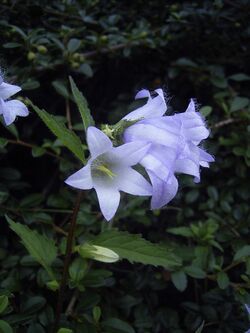Biology:Campanula trachelium
| Campanula trachelium | |
|---|---|

| |
| Scientific classification | |
| Kingdom: | Plantae |
| Clade: | Tracheophytes |
| Clade: | Angiosperms |
| Clade: | Eudicots |
| Clade: | Asterids |
| Order: | Asterales |
| Family: | Campanulaceae |
| Genus: | Campanula |
| Species: | C. trachelium
|
| Binomial name | |
| Campanula trachelium | |
Campanula trachelium, the nettle-leaved bellflower,[1] is a species of bellflower. It is a Eurasian blue wildflower native to Denmark and England and now naturalized in southeast Ireland. It is also found southward through much of Europe into Africa.
Common names
The alternate name throatwort is derived from an old belief that C. trachelium is a cure for sore throat, and the species name trachelium refers to its use as treatment of the throat in folk medicine.[2]
Other folknames include Our Lady's Bells because the color blue was identified with the Virgin Mary's scarf, veil, or shawl; Coventry Bells because C. trachelium was especially common in fields around Coventry; and "Bats-in-the-Belfry" or in the singular "Bat-in-the-Belfry", because the stamens inside the flower were like bats hanging in the bell of a church steeple.[3]
Description
Campanula trachelium is a perennial plant with one or more unbranched, often reddish, square-edged stems that are roughly hairy. The leaves grow alternately up the stems. The lower leaves are long-stalked and ovate with a heart-shaped base. The upper leaves have no stalks and are ovate or lanceolate, hairy with toothed margins. The inflorescence is a one sided spike with a few slightly nodding flowers. Each flower has five sepals which are fused, erect and hairy, and the five violet (or occasionally white) petals are fused into a bell that is hairy inside. There are five stamens and a pistil formed from three fused carpels. The fruit is a hairy, nodding capsule.[4]
Habitat
Campanula trachelium likes humus-rich soil and is found in broad-leaved woodlands, coppices, hedgerows and the margins of forests.[4]
References
- ↑ (xls) BSBI List 2007, Botanical Society of Britain and Ireland, https://bsbi.org/download/3542/, retrieved 2014-10-17
- ↑ "Campanula trachelium 'Bernice' - Dorset Perennials". https://dorsetperennials.co.uk/product/campanula-trachelium-bernice/.
- ↑ "Paghat's Garden". http://www.paghat.com/gardenhome.html.
- ↑ 4.0 4.1 "Nettle-leaved Bellflower: Campanula trachelium". NatureGate. http://www.luontoportti.com/suomi/en/kukkakasvit/nettle-leaved-bellflower. Retrieved 2013-12-30.
External links
Wikidata ☰ Q776583 entry
 |


